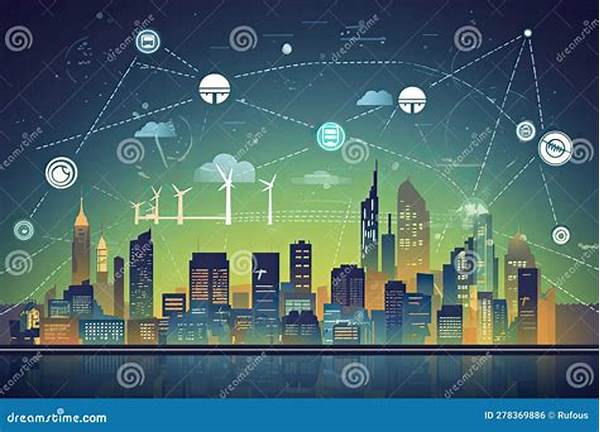Once upon a time, in the heart of a bustling city, a group of visionaries embarked on a mission. Their goal was to transform the urban landscape into a green oasis, powered by clean energy. They envisioned a world where cities would not only thrive but do so sustainably. Their journey brought forth the concept of renewable infrastructure for urban communities.
Read Now : High Street Community Artistic Talents
The Rise of Green Cities
In recent years, the world has witnessed a significant shift. Cities, once dominated by concrete and smog, are now seeing a new dawn with the implementation of renewable infrastructure for urban communities. It began with solar panels adorning rooftops, wind turbines gracing skylines, and urban gardens sprouting from unexpected places. These changes are not just aesthetic; they signify a deeper transformation.
The introduction of renewable infrastructure for urban communities marks a revolution. It means more than just energy; it’s about creating a sustainable lifestyle. In our city of dreams, parks come alive with wind-powered streetlamps, while electric buses weave seamlessly through streets. This shift is not just for environmentalists or policymakers; it’s for everyone who calls the city home. What seemed like a distant ideal is now becoming reality, and the community is at the heart of this change.
Stories from the Neighborhood
1. In a small, vibrant neighborhood, children now play under the shade of solar trees. These majestic structures symbolize the essence of renewable infrastructure for urban communities.
2. A local bakery has become a model for sustainable practice. Powered entirely by solar energy, it stands as a testament to the potential of renewable infrastructure for urban communities.
3. The city library, once an ancient structure, now boasts a green roof. Visitors find solace in this blend of nature and knowledge, thanks to renewable infrastructure for urban communities.
4. In the business district, a skyscraper generates its own electricity through cutting-edge wind technology. It reflects the forward-thinking attitude of renewable infrastructure for urban communities.
5. Community gardens have sprung up, teaching urbanites the value of sustainability. Here, renewable infrastructure for urban communities begins at a grassroots level.
Challenges and Triumphs
Navigating the transition to renewable infrastructure for urban communities is not without its hurdles. There are moments of doubt, financial constraints, and technical challenges. However, the drive for sustainability fuels unwavering determination. At the heart of it all lies the community’s resolution to create a better future.
With every setback, there is a triumph. A city once plagued by pollution now breathes cleaner air, drawing birds back to the treetops. Streets, once congested, see electric vehicles glide silently, transforming the urban soundscape. These improvements are the cornerstones of renewable infrastructure for urban communities, bringing hope and inspiration to citizens worldwide.
Vision for Tomorrow
Looking ahead, the potential for renewable infrastructure for urban communities is boundless. Picture a world where every building produces more energy than it consumes, where waste turns into resources, and where nature and technology coexist in harmony. It’s not just a vision but a possibility we can achieve together.
Read Now : Ergonomic Paint Roller Handle Design
The narrative of renewable infrastructure for urban communities is one of collaboration. It requires individuals, businesses, and governments to unite, breaking boundaries and fostering innovation. As cities evolve and adapt, this story continues to unfold, promising a sustainable tomorrow, one initiative at a time.
Building Bridges to a Sustainable Future
Walking through the city streets today, it’s easy to get lost in the hustle. But amidst the chaos, there’s a movement growing stronger every day, driven by renewable infrastructure for urban communities. This transformation is akin to bridging the past with the future, creating an urban tapestry of resilience and sustainability.
Imagine a bustling community center where workshops educate residents about rooftop gardens. Here, every conversation revolves around the benefits of renewable infrastructure for urban communities. It’s a place where children learn about solar energy through interactive exhibits, planting the seeds for tomorrow’s innovators. This is where the heart of transformation beats.
These efforts aren’t isolated. Across the globe, cities are witnessing similar stories unfold. In every corner, different aspects of renewable infrastructure for urban communities are blossoming, creating urban sanctuaries. It’s a testament to what is possible when vision meets action and communities commit to change.
The Power of Collective Action
In our journey toward a future powered by renewable infrastructure for urban communities, collective action stands as the greatest catalyst. Each person’s role, whether a policymaker, engineer, or citizen, is vital to this transformative process. The narrative is as much about individual choices as it is about widescale implementations.
As solar panels gather sunlight, converting it into electricity, they symbolize the synergy of human innovation and nature’s gifts. This collective effort transforms urban landscapes, proving that change is within reach. Each success story adds a chapter to the overarching tale of renewable infrastructure for urban communities, providing lessons and inspiration for the next generation.
Conclusion: A City Transformed
In summary, the journey toward a city defined by renewable infrastructure for urban communities is ongoing and ever-evolving. The transformation is visible not only in the physical environment but also in the spirit of its residents. These communities are more than just beneficiaries; they are active participants in crafting a sustainable future.
As the world continues to navigate the intricate web of challenges and opportunities posed by urbanization and climate change, the story of renewable infrastructure for urban communities will remain one of hope and determination. It echoes the potential for harmony between humanity and nature, offering a roadmap towards resilience and renewal for cities across the globe.
